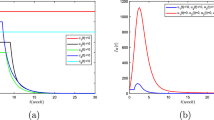Abstract
Age of infection (the time lapsed since infection) is an important factor to consider when modeling the transmission dynamics of influenza under the influence of antiviral treatment and drug-resistance. In this paper, we consider an influenza model which includes an age of infection. The model includes partial differential equations (PDEs) in order to describe the variable infectiousness and effect of antivirals during the infectious period. We derived the formulas for various reproduction numbers (RN) including \({\mathcal R_{SC}}\) (the controlled RN by one sensitive case), \({\mathcal R_{TC}}\) (the controlled total RN by one sensitive case), and \({\mathcal R_R}\) (the RN by one resistant case). The model analysis shows that \({\mathcal R_{SC}}\) and \({\mathcal R_R}\) determine both the global stability of the disease free equilibrium and the existence of the non-trivial equilibria. Local stabilities of the non-trivial equilibria are also discussed. Numerical simulations are conducted to not only confirm or extend the analytic results on qualitative behaviors of the system, but also reveal important quantitative properties of the disease dynamics influenced by antiviral treatment. These results are then used to assess the effectiveness of treatment programs in terms of both the RNs and the epidemic size. Our findings illustrate possibility that a higher level of antiviral use may lead to an increase of the epidemic size, despite the fact that there is a fitness cost of the drug-resistant strains. This suggests that programs for antiviral use should be designed carefully to avoid the adverse effect.
Similar content being viewed by others
References
Earn D.J.D., Dushoff J., Levin S.A.: Ecology and evolution of the flu. Trends Ecol. Evol. 17, 334–340 (2002)
Oxford J.S.: Influenza A pandemics of the 20th century with special reference to 1918: virology, pathology and epidemiology. Rev. Med. Virol. 10, 119–133 (2000)
Meltzer M.I., Cox N.J., Fukuda K.: The economic impact of pandemic influenza in the United States: priorities for intervention. Emerg. Infect. Dis. 5, 659–671 (1999)
Longini I.M. Jr, Nizanm A., Xu S., Ungchusak K., Hanshaoworakul W., Cummings D.A.T., Halloran M.E.: Containing pandemic influenza at the source. Science 309, 1083–1087 (2005)
Chan, M.: World now at the start of 2009 influenza pandemic. World Health Organization (2009-06-11)
Anderson R.M., May R.M.: Infectious diseases of humans: dynamics and control. Oxford University Press, Oxford (1991)
Alexander M.E., Bowman C.S., Feng Z., Gardam M., Moghadas S.M., Röst G., Wu J., Yan P.: Emergence of drug resistance: implications for antiviral control of pandemic influenza. Proc. R. Soc. B 274, 1675–1684 (2007)
Alexander M.E., Moghadas S.M., Röst G., Wu J.: A delay differential model for pandemic influenza with antiviral treatment. Bull. Math. Biol. 70, 382–397 (2008)
Lipsitch M., Cohen T., Murray M., Levin B.R.: Antiviral resistance and the control of pandemic influenza. PLoS Med. 4, 0111–0120 (2007)
Regoes R.R., Bonhoeffer S.: Emergence of drug-resistant influenza virus: population dynamical considerations. Science 312, 389–391 (2006)
Qiu Z., Feng Z.: Transmission dynamics of an influenza model with vaccintaion and antiviral treatment. Bull. Math. Biol. 72, 1–33 (2010)
Feng Z., Xu D., Zhao H.: Epidemiological models with non-exponentially distributed disease stages and applications to disease control. Bull. Math. Biol. 69, 1511–1536 (2007)
Lloyd A.L.: Destabilization of epidemic models with the inclusion of realistic distributions of infectious periods. Proc. Roy. Soc. Lond. B 268, 985–993 (2001)
Wearing H.J., Rohani P., Keeling M.J.: Appropriate models from the management of infectious diseases. PLoS Med. 7, 621–627 (2005)
Yan, P., Feng, Z.: Variability order of the latent and the infectious periods in a deterministic SEIR epidemic model and evaluation of control effectiveness. Math. Biosci. (2010). doi:10.1016/j.mbs.2009.12.007
Yang C.K., Brauer F.: Calculation of R 0 for age-of-infection models. Math. Biosci. Eng. 5(3), 585–599 (2008)
Kermack W.O., McKendrick A.G.: A contribution to the mathematical theory of epidemics. Proc. Roy. Soc. Lond. A 115, 700–721 (1927)
Thieme H.R., Castillo-Chavez C.: How may infection-age-dependent infectivity affect the dynamics if HIV/AIDs? SIAM J. Appl. Math. 53, 1447–1479 (1993)
Milner F.A., Pugliese A.: Periodic solutions: a robust numerical method for an SIR model of epidemics. J. Math. Biol. 39, 471–492 (1999)
Lloyd A.L.: Realistic distributions of infectious periods in epidemic models: changing patterns of persistence and dynamics. Theor. Popul. Biol. 60, 59–71 (2001)
Feng Z., Iannelli M., Milner F.A.: A two-strain tuberculosis model with age of infection. SIAM J. Appl. Math. 62, 1634–1656 (2002)
Feng Z., Li C.C., Milner F.A.: Schistosomiasis models with density dependence and age of infection in snail dynamics. Math. Biosci. 177&178, 271–286 (2002)
Li J., Zhou Y., Ma Z., Hyman J.M.: Epidemiological models for mutanting pathogens. SIAM J. Appl. Math. 65, 1–23 (2004)
Hyman J.M., Li J.: Infection-age structured epidemic models with behavior change or treatment. J. Biol. Dyns. 1, 109–131 (2007)
Iannelli, M.: Mathematical Theory of Age-structured Population Dynamics. Applied Mathematics Monographs 7, comitato nazionale per le scienze matematiche, Consiglio Nazionale delle Ricerche (C. N. R), Giardini, Pisa (1995)
Webb G.: Theory of nonlinear age-dependent population dynamics. Marcel Dekker, New York (1985)
Diekmann O., Heesterbeek J.A.P.: Mathematical epidemiology of infections disease: model building, analysis and interpretation. Wiley, New York (2000)
Mills C.E., Robins J.M., Lipsitich M.: Transmissibility of 1918 influenza. Nature 432, 904–906 (2004)
Rong L.B., Feng Z., Perelson A.S.: Mathematical analysis of age-structured HIV-1 dynamics with conbination antiviral theraphy. SIAM J. Appl. Math. 67, 731–756 (2007)
Iwami S., Suzuki T., Takeuchi Y.: Paradox of vaccination: is vaccination really effective against avian flu epidemics? PLoS ONE 4, e4915 (2009)
Author information
Authors and Affiliations
Corresponding author
Rights and permissions
About this article
Cite this article
Qiu, Z., Feng, Z. Transmission Dynamics of an Influenza Model with Age of Infection and Antiviral Treatment. J Dyn Diff Equat 22, 823–851 (2010). https://doi.org/10.1007/s10884-010-9178-x
Received:
Published:
Issue Date:
DOI: https://doi.org/10.1007/s10884-010-9178-x




